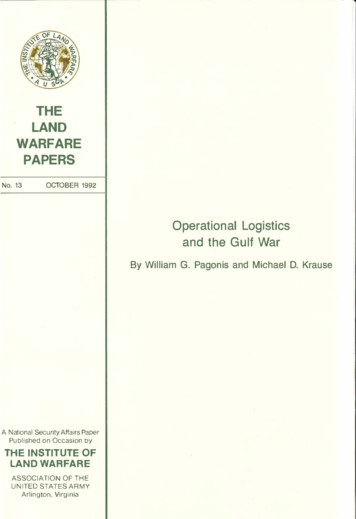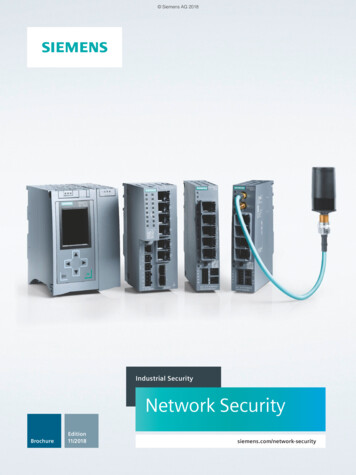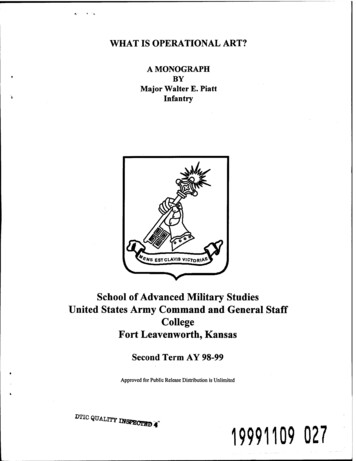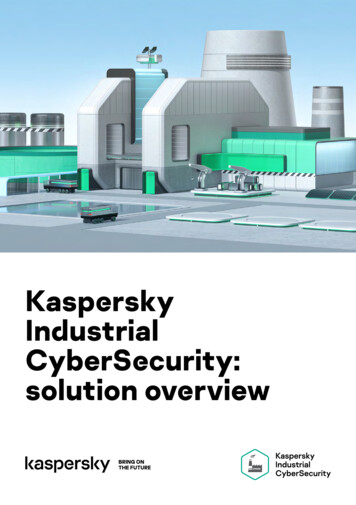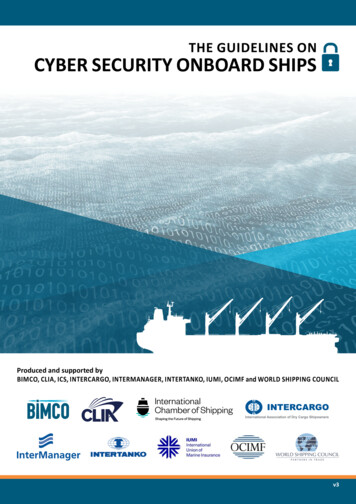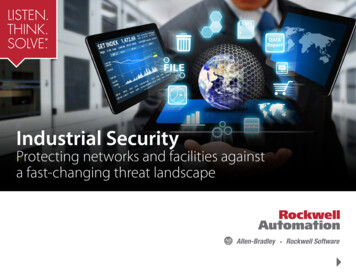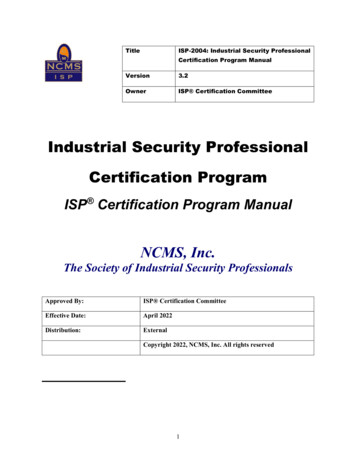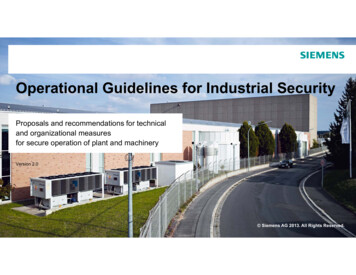
Transcription
Operational Guidelines for Industrial SecurityProposals and recommendations for technicaland organizational measuresfor secure operation of plant and machineryVersion 2.0 Siemens AG 2013. All Rights Reserved.
Operational Guidelines forIndustrial Security1. Overview2. Detailed Measures3. Summary Siemens AG 2013. All Rights Reserved.
Why Industrial Security is so important?Industrial Security is used to protect industrial machines and plantsagainst unauthorized access, sabotage, espionage and maliciousmanipulation.Possible consequences of security incidents: Loss of system availabilityImpairment of system performanceManipulation or loss of dataLoss of production controlEnvironmental disasterRisk of death and serious injuryDamage to company imageFinancial loss Establishing of security measures required – depending on individual risksPage 32013-07-11v2.0 Siemens AG 2013. All Rights Reserved.Industry Sector
Industrial SecurityDifferent requirements in office and production environmentsRequirements that a security solutionmust meet in an industrial context 24/7/365 availability has top priority Open standards for seamless communication and functionalityOffice SecurityIndustrial Security Common standards, e.g. Microsoft Software as base for automationsolutions Constant operability and assured system access System egrityAvailabilityConfidentiality Protection against maloperations and sabotage Know-how protection System and data integrity Continuous communication between office and production systemsfor real-time monitoring and controlling Data transfer in real time for efficient production processes Support throughout the lifecycle of a plant Security trail and change managementPage 42013-07-11v2.0 Siemens AG 2013. All Rights Reserved.Industry Sector
Industrial Security solutions require a holistic approach based on differentprotection layersPlant security Access blocked for unauthorized persons Physical prevention of access to critical componentsNetwork security Controlled interfaces between office and plant networke.g. via firewalls Further segmentation of plant networkSystem integrity Antivirus and whitelisting software Maintenance and update processes User authentication for plant or machine operators Integrated access protection mechanisms in automationcomponentsPage 52013-07-11v2.0 Siemens AG 2013. All Rights Reserved.Industry Sector
Industrial Security only works in cooperation between plant operators,system integrators and component manufacturersIEC62433 / ISA99 – Standard for Industrial SecurityExampleComponent manufacturer: Automation products with integrated security featuresSystem integrator: Secure configuration and integration of an automationcomponent into the entire systemPlant operator: Maintenance and update of security functionalityaccording to changing circumstances (e.g. new knownsecurity vulnerabilities)Page 62013-07-11v2.0 Siemens AG 2013. All Rights Reserved.Industry Sector
Measures must continuously be checked and aligned to an individual plantSecurity ManagementSecurity Management process Security Management forms a major part of any IndustrialSecurity concept Definition of Security measures depending on hazards andArisks identified in the plantRisk analysis Attaining and maintaining the necessary Security Level calls for arigorous and continuous Security Management process with: Risk analysis including definition of countermeasures aimed atreducing the risk to an acceptable levelDPolicies,OrganizationalmeasuresValidation &improvementB Coordinated organizational / technical measures Regular / event-driven repetition Products, systems and processes must meet applicable duty-of-TechnicalmeasuresCcare requirements, based on laws, standards, internal guidelinesand the state of the art.Page 72013-07-11v2.0 Siemens AG 2013. All Rights Reserved.Industry Sector
Operational Guidelines forIndustrial Security1. Overview2. Detailed Measures3. Summary Siemens AG 2013. All Rights Reserved.
Risk analysis is the first step to determine security measuresThe risk analysis is an important precondition for Security Management relating to a plantor machine, aimed at identifying and assessing individual hazards and risks. Identification of threatened objectsAmount of lossTypical content of a risk eptablerisksverylow Analysis of value and damage potential Threat and weak points analysisverylowlowmediumhighveryhighProbability of occurrence Identification of existing security measures Risk assessmentARisk analysisThe identified and unacceptable risks must, by way of suitable measures,be ruled out or typically reduced.Which risks are ultimately acceptable can only be specified individuallyfor the application concerned. However, neither a single measure nor acombination of measures can guarantee 100% security.Page idation &improvementBTechnicalmeasuresC Siemens AG 2013. All Rights Reserved.Industry Sector
Defense-in-Depth architecture to protect automated production plantsPlant securityRemoteAccessOffice networkInterface to Office-IT / for Remote Access Firewalls Proxy-Server Intrusion Detection / Prevention Systems (IDS/IPS)Plant networkSafetyPage 10Availability2013-07-11Know-howv2.0 Protection of PC-based Systems User management / Policies (e.g. password lifetime) Antivirus- / whitelisting softwareNetwork segmentation depending on protection goals Firewall VPN-GatewayProtection of control level Access protection, integrity and manipulation protection Know-how and copy-protection IP-Hardening (network robustness) Siemens AG 2013. All Rights Reserved.Industry Sector
Overview of security measures1. Plant security Security organization and policies Physical security2. Network security Network segmentation & DMZ Firewalls and VPN3. System integrityPage 11 Access protection System hardening Patch management Malware protection2013-07-11v2.0 Siemens AG 2013. All Rights Reserved.Industry Sector
1. Security organization and policiesEstablishing Security in the organizationIndustrial Security cannot be put into effect by technical measures alone, but has to be actively applied in all relevantcompany units in the sense of a continuous process.Industrial Security as a management duty Support for Industrial Security by Senior Management Clearly defined and agreed responsibilities for Industrial Security,IT Security and physical security in the company Establishing a cross-disciplinary organization / networkwith responsibility for all Industrial Security affairsEnhancing Security awareness Drafting and regular holding of training programs for production-related Security topics Security assessments with Social Engineering aspectsPage 122013-07-11v2.0 Siemens AG 2013. All Rights Reserved.Industry Sector
1. Security organization and policiesPolicies and processesDefinition of policies and processes in order to ensure a uniform procedure and to support the upholding of the definedIndustrial Security concept.Examples of Security-relevant policies Uniform stipulations for acceptable Security risks Reporting mechanisms for unusual activities and events Communication and documentation of Security incidents Use of mobile PCs, Smartphones and data storage in the production area(e.g. forbidding their use outside this area / the production network)Examples of Security-relevant processes Dealing with known / corrected weak points in components used Procedure in the event of Security incidents (Incident Response Plan) Procedure for restoring production systems after Security incidents Recording and evaluation of Security events and configuration changes Test / inspection procedure for external data carriers before use in the production areaPage 132013-07-11v2.0 Siemens AG 2013. All Rights Reserved.Industry Sector
1. Physical securityPhysical access protection of critical production facilities Measures and processes to prevent access byunauthorized persons to the plant Physical separation of various production areas withdifferentiated access authorizations Physical access protection for critical automationcomponents (e.g. locked control cabinets) Coordinated guidelines for physical security andplant IT security requiredPage 142013-07-11v2.0 Siemens AG 2013. All Rights Reserved.Industry Sector
1. Physical securityPhysical access protection of critical production facilitiesRisks Access by unauthorized persons to production premises / building Physical damage to or changing of production equipment Loss of confidential information through espionageMeasuresCompany security Company premises fenced off and under surveillance Access controls, locks / ID card readers and / or security staff Visitors / external personnel escorted by company staffPhysical production security Separate access controls for production areas Critical components in securely lockable control cubicles / rooms including surveillance and alarm facilities Cordoned-off production areas with restricted accessPage 152013-07-11v2.0 Siemens AG 2013. All Rights Reserved.Industry Sector
Overview of security measures1. Plant security Security organization and policies Physical security2. Network security Network segmentation & DMZ Firewalls and VPN3. System integrityPage 16 Access protection System hardening Patch management Malware protection2013-07-11v2.0 Siemens AG 2013. All Rights Reserved.Industry Sector
2. Network securityProtection of automation components based on segmented production networksEthernet-based fieldbus systems are well established in today’s automation solutions because of their advantages likeperformance and open communication from control level to field level. However this trend also leads to increased riskswhich have to be addressed by security measures: Network protection mechanism like firewalls, whichblocks or regulates communication between officeand plant networks Segmentation of production networks in different securedautomation networks (network cells). This protectsautomation components within these cells againstunauthorized access, network overload, etc. Separation of a plant network into different subnets withlimited and secure communication between these subnets(„Secure Automation Islands“)Page 172013-07-11v2.0 Siemens AG 2013. All Rights Reserved.Industry Sector
2. Network securitySeparation of production and office networks The first step in network segmentation is strict separationbetween the production networks and the other companynetworks In the simplest case, separation is provided by means of asingle firewall system that controls and regulatescommunication between the networks In the more secure variant, the link is via a separate DMZrespective perimeter network. Direct communicationbetween the production and the company networks iscompletely blocked by firewalls; communication can takeplace only indirectly via servers in the DMZ network The production networks should likewise be subdivided intoseparate automation cells, in order to safeguard criticalcommunication mechanismsPage 182013-07-11v2.0 Siemens AG 2013. All Rights Reserved.Industry Sector
2. Network securityThe security cells / zones concept A “cell” or “zone” is a network segment sealed off for security purposes There are access controls at the “entry to the cell” in the form of security network components Devices without their own access protection mechanisms are safeguarded within the cell.This principle is thus suitable for retrofitting in existing installations The cell can be protected against network overload by bandwidth restriction,and data traffic within the cell upheld without disturbance Real-time communication remains unaffected within the cell Provides protection for safety applications within the network cell Secure channel and therefore secure communication between cellsProtection of automation equipment and industrial communication by means of: Firewall/VPN appliances VPN client software for IPCs or PCs,to create secure and authenticated linksto the Security AppliancesPage 192013-07-11v2.0 Siemens AG 2013. All Rights Reserved.Industry Sector
2. Network securityCriteria for network segmentation In the cell protection concept a network segment is safeguarded from outside against unauthorized access. Data trafficwithin the cell is not controlled by the Security Appliance and must therefore be assumed to be secure or supplementedwith protection measures within the cell, e.g. Port Security in the case of switches. The size of a Security cell depends primarily on the protection objectives of the components it contains, because one cellmay only include components with the same protection requirement. It is recommended to plan network structure based on your production processes. This allows the definition of networksegments with less communication across network borders and minimal firewall exception rules. There are also the following recommendations for network size and network segmentation, resulting from performancerequirements: All devices of a PROFINET IO system belong to one cell Devices between which there is much communication should be combined in one cell Devices that communicate only with devices of one cell should, if the protection objective is identical, be integrated in thiscellPage 202013-07-11v2.0 Siemens AG 2013. All Rights Reserved.Industry Sector
2. Network securityPossible risks and recommended measuresRisks Unauthorized access to automation devices without their own Security Mechanisms Deterioration in equipment availability due to network overload Espionage / manipulation of data transfer between automation systemsMeasures Division of the automation network into appropriate network segments and control of incoming and outgoing data trafficby a firewall (perimeter security). For example, critical network protocols can be blocked. Bandwidth restriction, for example in cell firewall or in switches. Network overload from outside the cell cannot affectthose inside. Data transfer via non-secure networks, e.g. between cells or from clients to cells, can be encrypted and authenticatedwith the Security or VPN Appliance that controls access to the cell.Page 212013-07-11v2.0 Siemens AG 2013. All Rights Reserved.Industry Sector
2. Network securityExample: Network segmentation with cell protection concept with security appliancesSIMATIC S7 and PCcommunication processors(CP) with “Securityintegrated”(Firewall, VPN)can be used as alternative orextension to securityappliances (SCALANCE S) toprotect automation devicesand networks.S7 communicationprocessors protect underlyingnetworks by an integratedfirewall. Additionallyencrypted VPN connectionscan be established directly tothe PLC itself (S7-300, S7400 or S7-1500).Page 222013-07-11v2.0 Siemens AG 2013. All Rights Reserved.Industry Sector
2. Network securityExample: Secure remote maintenance with SCALANCE S623TaskSystem access via the Internet usingan encrypted VPN tunnel.SolutionStarting point (e.g. system integrator):e.g. SCALANCE S or SSC as VPNclientEnd point (e.g. end client system):SCALANCE S623 as VPN Server Red port:Connection to plant network Yellow port:Connection of modem / router Green port:Connection of secure cellsPage 232013-07-11v2.0 Siemens AG 2013. All Rights Reserved.Industry Sector
2. Network securityExample: Secure remote maintenance via cellular networks with SCALANCE M875TaskClassical applications such as remoteprogramming, parameterization anddiagnosis, but also monitoring ofmachines and plants installedworldwide can be performed from aservice center that is connected overthe Internet.SolutionAny IP-based devices, particularlyautomation devices that aredownstream of the SCALANCE M875in the local network, can be accessed.Multimedia applications like videostreaming can be implemented thanksto the increased bandwidth in theuplink. The VPN functionality allows thesecure transfer of data around theworld.Page 242013-07-11v2.0 Siemens AG 2013. All Rights Reserved.Industry Sector
2. Network securityExample: Secure remote maintenance via Siemens Remote Service Platform (SRS)CustomerAdministratorSiemens Service CenterRemote maintenanceControl Center (24/7)Enhanced ServiceTechnology ExpertRemote ExpertAuthenticationand AuthorizationAnalysis ofConnectionIT-Safetyby ISO 27001and by CERTData monitorand AnalysisReports andAlarmsDatabaseServicesDSL/Internet, Mobile Radio, ISDN, AnalogueWorldwide Customer age 252013-07-11v2.0 Siemens AG 2013. All Rights Reserved.Industry Sector
Overview of security measures1. Plant security Security organization and policies Physical security2. Network security Network segmentation & DMZ Firewalls and VPN3. System integrityPage 26 Access protection System hardening Patch management Malware protection2013-07-11v2.0 Siemens AG 2013. All Rights Reserved.Industry Sector
3. System integrityAccess protection for configuration (Engineering) In order to prevent unauthorized configuration changesto automation components, it is extremely advisable tomake use of the integrated access protection mechanisms. These include for example: PLCs (“protection level”) HMI Panels („Secure mode“) Managed Switches (Password) WLAN Access Points (Password) Firewalls (Passwords / Certificates) Utilization of components with integrated security featureslike the S7-1500 controller for example Use various passwords that are as secure as possible(if possible at least 12 upper- and lower-case characters, numbers and where applicable special characters) For easier password handling a common password manager is recommended. In case of coordination among multiplepersons this one should be stored on a central network share including access rights.Page 272013-07-11v2.0 Siemens AG 2013. All Rights Reserved.Industry Sector
3. System integrityAccess protection for operations (Runtime) Typically, plant / machinery is operated by various persons; central user administration is therefore advisable This is based on the user accounts of a Windows domain or of a Windows Active Directory. The linking of the SIMATIC(HMI) runtime applications is in this case via SIMATIC Logon Specifying / enforcing of security guidelines (e.g. password validity, monitoring of incorrect logging on, etc.) Central user administration simplifies regular review of access authorizations (e.g. identifying disused accounts) Depending on security requirements separated networksegments could also use different Windows domainsCentral administration of User accounts / groups PoliciesPage 282013-07-11v2.0 Siemens AG 2013. All Rights Reserved.Industry Sector
3. System integrityAccess protection for network components (Network) Access protection for networks by means of Port Security with Switch Ports: MAC or IP access lists restrict access Port Security with central device administration and RADIUS authentication (802.1x) Perimeter security of a network in relation to other networks (e.g. Internet) with firewalls WLAN security Safeguarding of data transfer in accordance with WPA2 / IEEE 802.11i for Security Advanced Encryption Standard (AES) for encoding data Central device administration with RADIUS authentication (in accordance with 802.1x) Protected configuration accesses to web interface by way of HTTPS and secure logging in via SSHPage 292013-07-11v2.0 Siemens AG 2013. All Rights Reserved.Industry Sector
3. System integritySystem hardening reduces possible attack scenariosNetwork servicesHardware interfaces Network services are a potentialsecurity risk in general In order to minimize risks, on allautomation components only theservices actually required should beactivated All activated services (especiallyWebserver, FTP, Remote Desktop,etc.) should be taken into account inthe security concept IP hardening measures in automationand drives products enhance securitywithout the need for separate userconfigurationPage 302013-07-11v2.0 Hardware interfaces constitute a risk ifunauthorized access via them toequipment or the system is possible Unused interfaces should therefore bedeactivated: Ethernet/Profinet ports WLAN, Bluetooth USB, Firewire, etc. Protection by deactivation ormechanical blocking Deactivate booting and autostartmechanisms of external mediaUser accounts Every active user account enablesaccess to the system and is thus apotential risk Reduce configured / activated useraccounts to the really necessaryminimum Use secure access data for existingaccounts Regular checks, particularly of locallyconfigured user accounts Important: Change predefined defaultpasswords during commissioningphase (where available). Siemens AG 2013. All Rights Reserved.Industry Sector
3. System integrityPatch management fixes security vulnerabilities in operating system and applicationsMost security attacks nowadays take place via weak points for which the manufacturers already have patches.Only in rare cases are zero day exploits encountered, where the weak point is not yet known or updates are not available. The installation of patches and updates is an important measure to enhance security Siemens supports with compatibility tests of Microsoft security patches: SIMATIC PCS /22754447 SIMATIC w/en/18752994 SIMOTION /en/22159441 SINUMERIK PCU50/70: 9739695 System-specific compatibility tests recommended Patch distribution via central patch server in DMZ andWindows Server Update Services (WSUS) Set up of update groups and processes for online updatessimplifies patch distribution (e.g. for redundant systems)Page 312013-07-11v2.0 Siemens AG 2013. All Rights Reserved.Industry Sector
3. System integrityFirmware updates for more security within automation devices Even such automation components that do not use a standard PC operating system may require software updatesto fix security related vulnerabilities. You will get information at our Siemens Industrial Security website (http://www.siemens.com/industrialsecurity)as well as our product newsletters or RSS feeds. As soon as information on a vulnerability becomes available, the weak point should be evaluated for relevanceto the application concerned Depending thereon, it can be decided whether further measures should be taken: No action, as existing measures provide sufficient protection Additional external measures in order to uphold the security level Installation of latest firmware updates to eliminate the weak point The procedure comparable with a risk analysis like at the beginning, but with restricted focusPage 322013-07-11v2.0 Siemens AG 2013. All Rights Reserved.Industry Sector
3. System integrityIdentifying / preventing malware with virus scanners Suitable antivirus software should be used to identifymalware and to prevent further spreading Depending on the particular case, certain aspects shouldhowever be taken into account: Performance loss due to scan procedure (e.g. onlyautomatic scan of incoming data transfer and manualscan during maintenance pauses) Regular updating of virus signatures – if applicablevia central server Availability must generally be assured even in thecase of infection with malware. This means that thevirus scanner must under no circumstances: Remove files or block access thereto Place files in quarantine Block communication Shut systems down Siemens supports with compatibility tests with: *): Trend Micro Office Scan Symantec Endpoint Protection McAfee VirusScan Enterprise Further information are available in our compatibility tool:http://www.siemens.com/kompatool*) Please note the compatibility must be verified for each specific configurationPage 332013-07-11v2.0 Siemens AG 2013. All Rights Reserved.Industry Sector
3. System integrityIdentifying / preventing malware by whitelistingBasic principle Siemens supports with compatibility tests with *) : Whitelisting mechanisms provide additional protectionagainst undesired applications or malware, as well asunauthorized changes to installed applications Whitelisting software creates or contains a list of programsand applications that are allowed to run on the PC McAfee Application Control For further information go en/49386558http://www.siemens.com/kompatool Software that is not listed in this “white list“ is prevented fromrunningAdvantages No regular or delayed pattern updates Additional protection mechanism Protection against unknown malware (zero day exploits)*) Please note the compatibility must be verified for each specific configurationPage 342013-07-11v2.0 Siemens AG 2013. All Rights Reserved.Industry Sector
3. System integrityPossible risks and recommended measuresRisks Manipulation / espionage via unauthorized access to devices configuration Unauthorized operating activities Limited device availability due to malware installation and replicationMeasures Utilization of access control mechanisms in automation components, which limits access to configuration data andsettings to authorized persons only. Implementation of individual hardening measures for each automation component to reduce targets Installation of available updates in case of fixed security vulnerabilities or establishing alternative protection measures Usage of antivirus and whitelisting mechanisms as protection mechanism against malwarePage 352013-07-11v2.0 Siemens AG 2013. All Rights Reserved.Industry Sector
Reviewing of measuresAReviews and improvementsRisk analysisAfter implementation of all planned measures aSecurity Audit is conducted to ensure that measures have been put into practice as scheduled,D these measures eliminate / reduce the identified risks as expected.Depending on the results, measures can beamended / supplemented in order to attain the necessary security.Policies,Organizational BmeasuresValidation &improvementTechnicalmeasuresCRepeating the risk analysisDue to the changes in security threats, regular repetition of the risk analysis is required inorder to ensure the security of plant / machinery Following certain occurrences (expansion of or changes to plant / machinery, significantchanges in security threats, etc.) Annual check of whether a fresh risk analysis is requiredPage 362013-07-11v2.0 Siemens AG 2013. All Rights Reserved.Industry Sector
Operational Guidelines forIndustrial Security1. Overview2. Detailed Measures3. Summary Siemens AG 2013. All Rights Reserved.
The Siemens Industrial Security Concept is based on five key points whichcover the essential protection areasIndustrial Security ConceptImplementation of practicable and comprehensive Security ManagementThe interfaces to office IT and the Internet/Intranet are subject to clearly definedregulations - and are monitored accordingly.PC-based systems (HMI, engineering and PC-based controls) must be protectedwith the aid of anti-virus software, whitelisting and integrated security mechanisms.The control level is protected by various integrated security functions withinautomation and drive components.Communication must be monitored and can be intelligently segmented by meansof firewalls.Page 382013-07-11v2.0 Siemens AG 2013. All Rights Reserved.Industry Sector
Industrial Security: What we have to offerIndustrial Security ServicesSecurity ManagementProducts & SystemsComprehensive services throughout the lifecycle of acustomized security solutionSupport in the introduction and maintenance of technicaland organizational security measures based on standardsand guidelinesThoroughly thought-out security concepts for automationcomponents (PCs, controllers, networks) in the sense ofTotally Integrated AutomationFurther individual support in planning / implementing an Industrial Security Conceptis available from our Industrial Security ServicesPage 392013-07-11v2.0 Siemens AG 2013. All Rights Reserved.Industry Sector
Industrial Security ServicesTechnological OverviewIndustrial IT Security ServicesSecurity ManagementProducts & SystemsSecurity managementManaged ServiceUpdate, upgrade and modernizationSecurity AssessmentsIndustrial Security Health CheckPage 402013-07-11v2.0Integral Monitoring & AnalyticsBackup and recoveryMonitoringVirus Protectionand WhitelistingHardeningSignaturesIPS / IDSFirewallSecurity information and event managementIndustrial automation specific correlation rulesManaged Servicesfor extensive supportSecurity PackagesReduce risk of vulnerabilities throughstandardized packagesProfessional PackagesUpgrade and ModernizationConsultingSales SupportSecurity AssessmentIdentification of risks anddefinition of mitigations Siemens AG 2013. All Rights Reserved.Industry Sector
Industrial Security ServicesSecurity AssessmentsCustomer requirementOur solutionConsultation andreview of the currentsituation, regardingindustrial securitywithin the plant.The result of the security assessmentis a report and the baseline for decisionson next steps.Analysis and reportingof further steps toreduce security risks.Page 412013-07-11Industrial IT Security ServicesSecurity ManagementProducts & SystemsIn this report the current risk level,identified vulnerabilities and thecompleteness of the implementedsecurity measures will be provided.Documentation also includes prioritizedrecommendations how to improve andenhance the security level of the system,depending on the extend of the orderedservices.v2.0 Siemens AG 2
Industrial Security solutions require a holistic approach based on different protection layers Plant security Access blocked for unauthorized persons Physical prevention of access to critical components Network security Controlled interfaces between office and plant network e.g. via firewal
